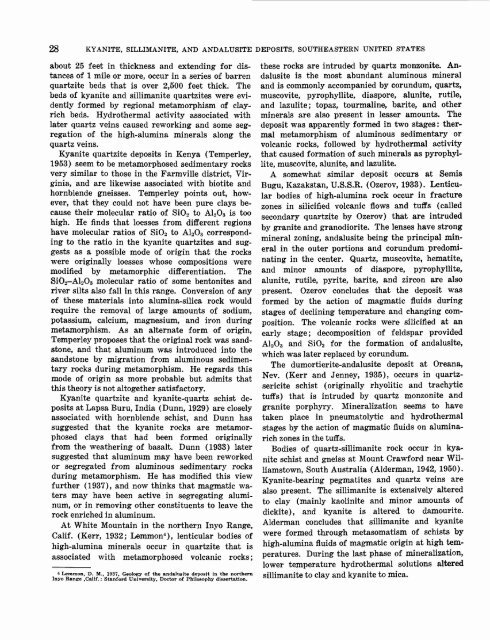Kyanite, Sillimanite, and Andalusite Deposits of the Southeastern ...
Kyanite, Sillimanite, and Andalusite Deposits of the Southeastern ...
Kyanite, Sillimanite, and Andalusite Deposits of the Southeastern ...
Create successful ePaper yourself
Turn your PDF publications into a flip-book with our unique Google optimized e-Paper software.
28 KYANITE, SILLIMANITE, AND ANDALUSITE DEPOSITS, SOUTHEASTERN UNITED STATES<br />
about 25 feet in thickness <strong>and</strong> extending for distances<br />
<strong>of</strong> 1 mile or more, occur in a series <strong>of</strong> barren<br />
quartzite beds that is over 2,500 feet thick. The<br />
beds <strong>of</strong> kyanite <strong>and</strong> sillimanite quartzites were evidently<br />
formed by regional metamorphism <strong>of</strong> clayrich<br />
beds. Hydro<strong>the</strong>rmal activity associated with<br />
later quartz veins caused reworking <strong>and</strong> some segregation<br />
<strong>of</strong> <strong>the</strong> high-alumina minerals along <strong>the</strong><br />
quartz veins.<br />
<strong>Kyanite</strong> quartzite deposits in Kenya (Temperley,<br />
1953) seem to be metamorphosed sedimentary rocks<br />
very similar to those in <strong>the</strong> Farmville district, Virginia,<br />
<strong>and</strong> are likewise associated with biotite <strong>and</strong><br />
hornblende gneisses. Temperley points out, however,<br />
that <strong>the</strong>y could not have been pure clays because<br />
<strong>the</strong>ir molecular ratio <strong>of</strong> Si02 to A1203 is too<br />
high. He finds that loesses from different regions<br />
have molecular ratios <strong>of</strong> Si02 to A1203 corresponding<br />
to <strong>the</strong> ratio in <strong>the</strong> kyanite quartzites <strong>and</strong> suggests<br />
as a possible mode <strong>of</strong> origin that <strong>the</strong> rocks<br />
were originally loesses whose compositions were<br />
modified by metamorphic differentiation. The<br />
Sid2-Al203 molecular ratio <strong>of</strong> some bentonites <strong>and</strong><br />
river silts also fall in this range. Conversion <strong>of</strong> any<br />
<strong>of</strong> <strong>the</strong>se materials into alumina-silica rock would<br />
require <strong>the</strong> removal <strong>of</strong> large amounts <strong>of</strong> sodium,<br />
potassium, calcium, magnesium, <strong>and</strong> iron during<br />
metamorphism. As an alternate form <strong>of</strong> origin,<br />
Temperley proposes that <strong>the</strong> original rock was s<strong>and</strong>stone,<br />
<strong>and</strong> that aluminum was introduced into <strong>the</strong><br />
s<strong>and</strong>stone by migration from aluminous sedimentary<br />
rocks during metamorphism. He regards this<br />
mode <strong>of</strong> origin as more probable but admits that<br />
this <strong>the</strong>ory is not altoge<strong>the</strong>r satisfactory.<br />
<strong>Kyanite</strong> quartzite <strong>and</strong> kyanite-quartz schist deposits<br />
at Lapsa Buru, India (Dunn, 1929) are closely<br />
associated with hornblende schist, <strong>and</strong> Dunn has<br />
suggested that <strong>the</strong> kyanite rocks are metamorphosed<br />
clays that had been formed originally<br />
from <strong>the</strong> wea<strong>the</strong>ring <strong>of</strong> basalt. Dunn (1933) later<br />
suggested that aluminum may have been reworked<br />
or segregated from aluminous sedimentary rocks<br />
during metamorphism. He has modified this view<br />
fur<strong>the</strong>r (1937), <strong>and</strong> now thinks that magmatic waters<br />
may have been active in segregating aluminum,<br />
or in removing o<strong>the</strong>r constituents to leave <strong>the</strong><br />
rock enriched in aluminum.<br />
At White Mountain in <strong>the</strong> nor<strong>the</strong>rn Inyo Range,<br />
Calif. (Kerr, 1932; Lemmon4), lenticular bodies <strong>of</strong><br />
high-alumina minerals occur in quartzite that is<br />
associated with metamorphosed volcanic rocks;<br />
4 Lemmon, D. M., 1937, Geology <strong>of</strong> <strong>the</strong> <strong>and</strong>alusite deposit in <strong>the</strong> nor<strong>the</strong>rn<br />
Inyo Range ,Calif.: Stanford University, Doctor <strong>of</strong> Philosophy dissertation.<br />
<strong>the</strong>se rocks are intruded by quartz monzonite. <strong>Andalusite</strong><br />
is <strong>the</strong> most abundant aluminous mineral<br />
<strong>and</strong> is commonly accompanied by corundum, quartz,<br />
muscovite, pyrophyllite, diaspore, alunite, rutile,<br />
<strong>and</strong> lazulite; topaz, tourmaline, barite, <strong>and</strong> o<strong>the</strong>r<br />
minerals are also present in lesser amounts. The<br />
deposit was apparently formed in two stages: <strong>the</strong>rmal<br />
metamorphism <strong>of</strong> aluminous sedimentary or<br />
volcanic rocks, followed by hydro<strong>the</strong>rmal activity<br />
that caused formation <strong>of</strong> such minerals as pyrophyllite,<br />
muscovite, alunite, <strong>and</strong> lazulite.<br />
A somewhat similar deposit occurs at Semis<br />
Bugu, Kazakstan, U.S.S.R. (Ozerov, 1933). Lenticular<br />
bodies <strong>of</strong> high-alumina rock occur in fracture<br />
zones in silicified volcanic flows <strong>and</strong> tuffs (called<br />
secondary quartzite by Ozerov) that are intruded<br />
by granite <strong>and</strong> granodiorite. The lenses have strong<br />
mineral zoning, <strong>and</strong>alusite being <strong>the</strong> principal mineral<br />
in <strong>the</strong> outer portions <strong>and</strong> corundum predominating<br />
in <strong>the</strong> center. Quartz, muscovite, hematite,<br />
<strong>and</strong> minor amounts <strong>of</strong> diaspore, pyrophyllite,<br />
alunite, rutile, pyrite, barite, <strong>and</strong> zircon are also<br />
present. Ozerov concludes that <strong>the</strong> deposit was<br />
formed by <strong>the</strong> action <strong>of</strong> magmatic fluids during<br />
stages <strong>of</strong> declining temperature <strong>and</strong> changing composition.<br />
The volcanic rocks were silicified at an<br />
early stage; decomposition <strong>of</strong> feldspar provided<br />
A1203 <strong>and</strong> Si02 for <strong>the</strong> formation <strong>of</strong> <strong>and</strong>alusite,<br />
which was later replaced by corundum.<br />
The dumortierite-<strong>and</strong>alusite deposit at Oreana,<br />
Nev. (Kerr <strong>and</strong> Jenney, 1935), occurs in quartzsericite<br />
schist (originally rhyolitic <strong>and</strong> trachytic<br />
tuffs) that is intruded by quartz monzonite <strong>and</strong><br />
granite porphyry. Mineralization seems to have<br />
taken place in pneumatolytic <strong>and</strong> hydro<strong>the</strong>rmal<br />
stages by <strong>the</strong> action <strong>of</strong> magmatic fluids on aluminarich<br />
zones in <strong>the</strong> tuffs.<br />
Bodies <strong>of</strong> quartz-sillimanite rock occur in kyanite<br />
schist <strong>and</strong> gneiss at Mount Crawford near Williamstown,<br />
South Australia (Alderman, 1942, 1950).<br />
<strong>Kyanite</strong>-bearing pegmatites <strong>and</strong> quartz veins are<br />
also present. The sillimanite is extensively altered<br />
to clay (mainly kaolinite <strong>and</strong> minor amounts <strong>of</strong><br />
dickite), <strong>and</strong> kyanite is altered to damourite.<br />
Alderman concludes that sillimanite <strong>and</strong> kyanite<br />
were formed through metasomatism <strong>of</strong> schists by<br />
high-alumina fluids <strong>of</strong> magmatic origin at high temperatures.<br />
During <strong>the</strong> last phase <strong>of</strong> mineralization,<br />
lower temperature hydro<strong>the</strong>rmal solutions altered<br />
sillimanite to clay <strong>and</strong> kyanite to mica.
















